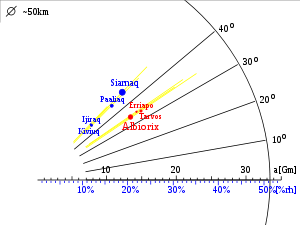.gif)
Albiorix (moon)
Encyclopedia
Albiorix is a prograde
irregular
satellite
of Saturn
. It was discovered by Holman
, et al. in 2000, and given the temporary designation S/2000 S 11.
Albiorix is the largest member of the Gallic group
of irregular satellites.
It was named in August 2003 for Albiorix, "a Gallic giant who was considered to be the king of the world." The name is known from an inscription found near the French town of Sablet
which identifies him with the Roman god Mars
(an interpretatio romana
).
 Albiorix orbits Saturn at a distance of about 16 Gm and its diameter is estimated at 32 kilometers, assuming an albedo
Albiorix orbits Saturn at a distance of about 16 Gm and its diameter is estimated at 32 kilometers, assuming an albedo
of 0.04.
The diagram illustrates the Albiorigian orbit in relation to other prograde irregular satellites of Saturn. The eccentricity of the orbits is represented by the yellow segments extending from the pericentre
to the apocentre
.
Given the similarity of the orbital elements and the homogeneity of the physical characteristics with other members of the Gallic group, it was suggested that these satellites could have a common origin in the break-up of a larger moon.
Varying colours revealed recently suggest a possibility of a large crater, leading to an alternative hypothesis that Erriapus and Tarvos
could be fragments of Albiorix following a near-break-up collision with another body.
On 2010 July 31, the Cassini–Huygens mission will take light-curve data.
Prograde
Prograde can refer to:*Prograde or direct motion, in astronomy, a type of motion of astronomical bodies* Prograde metamorphism, in geology, describes mineral changes in rocks under increasing pressure and/or temperature conditions...
irregular
Irregular satellite
In astronomy, an irregular moon is a natural satellite following a distant, inclined, and often eccentric and retrograde orbit. They are believed to have been captured by their parent planet, unlike regular satellites, which form in situ....
satellite
Natural satellite
A natural satellite or moon is a celestial body that orbits a planet or smaller body, which is called its primary. The two terms are used synonymously for non-artificial satellites of planets, of dwarf planets, and of minor planets....
of Saturn
Saturn
Saturn is the sixth planet from the Sun and the second largest planet in the Solar System, after Jupiter. Saturn is named after the Roman god Saturn, equated to the Greek Cronus , the Babylonian Ninurta and the Hindu Shani. Saturn's astronomical symbol represents the Roman god's sickle.Saturn,...
. It was discovered by Holman
Matthew J. Holman
Matthew J. Holman is a Smithsonian Astrophysicist and lecturer at Harvard University. Holman studied at MIT, where he received his bachelor's degree in mathematics in 1989 and his PhD in planetary science in 1994....
, et al. in 2000, and given the temporary designation S/2000 S 11.
Albiorix is the largest member of the Gallic group
Saturn's Gallic group of satellites
The Gallic group is a dynamical grouping of the prograde irregular satellites of Saturn following similar orbits. Their semi-major axes range between 16 and 19 Gm, their inclinations between 35° and 40°, and their eccentricities around 0.53....
of irregular satellites.
It was named in August 2003 for Albiorix, "a Gallic giant who was considered to be the king of the world." The name is known from an inscription found near the French town of Sablet
Sablet
Sablet is a commune in the Vaucluse department in the Provence-Alpes-Côte d'Azur region in southeastern France.It is a fortified Provençal village rich in history.-Geography:...
which identifies him with the Roman god Mars
Mars (mythology)
Mars was the Roman god of war and also an agricultural guardian, a combination characteristic of early Rome. He was second in importance only to Jupiter, and he was the most prominent of the military gods worshipped by the Roman legions...
(an interpretatio romana
Interpretatio graeca
Interpretatio graeca is a Latin term for the common tendency of ancient Greek writers to equate foreign divinities to members of their own pantheon. Herodotus, for example, refers to the ancient Egyptian gods Amon, Osiris and Ptah as "Zeus", "Dionysus" and "Hephaestus", respectively.-Roman...
).

Albedo
Albedo , or reflection coefficient, is the diffuse reflectivity or reflecting power of a surface. It is defined as the ratio of reflected radiation from the surface to incident radiation upon it...
of 0.04.
The diagram illustrates the Albiorigian orbit in relation to other prograde irregular satellites of Saturn. The eccentricity of the orbits is represented by the yellow segments extending from the pericentre
Apsis
An apsis , plural apsides , is the point of greatest or least distance of a body from one of the foci of its elliptical orbit. In modern celestial mechanics this focus is also the center of attraction, which is usually the center of mass of the system...
to the apocentre
Apsis
An apsis , plural apsides , is the point of greatest or least distance of a body from one of the foci of its elliptical orbit. In modern celestial mechanics this focus is also the center of attraction, which is usually the center of mass of the system...
.
Given the similarity of the orbital elements and the homogeneity of the physical characteristics with other members of the Gallic group, it was suggested that these satellites could have a common origin in the break-up of a larger moon.
Varying colours revealed recently suggest a possibility of a large crater, leading to an alternative hypothesis that Erriapus and Tarvos
Tarvos (moon)
Tarvos , or Saturn XXI, is a prograde irregular satellite of Saturn. It was discovered by John J. Kavelaars et al. on September 23, 2000, and given the temporary designation S/2000 S 4...
could be fragments of Albiorix following a near-break-up collision with another body.
On 2010 July 31, the Cassini–Huygens mission will take light-curve data.

